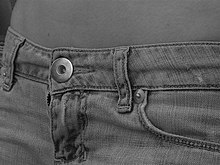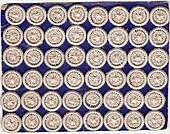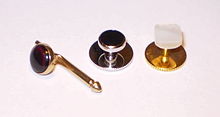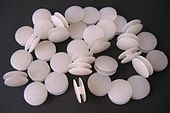stud
A button is a small, solid, usually round object on an item of clothing. Together with a buttonhole or a loop, it is used to close clothes or shoes as well as containers such as bags , baskets , boxes and others.
history
The button as a decorative object without a buttonhole or loop was already known in ancient times. Buttons with buttonholes (instead of loops) were invented in Germany in the 13th century. The new method spread rapidly in Europe by the 14th century and resulted in a fashion with tight-fitting dresses.
use
When closing, the button, which is firmly connected to one half of the fabric, is either pulled through a loop adapted to the size on the other half or passed through a hemmed cut in the fabric (buttonhole) to close the opening. The shape of the button, its size, the material and the application are subject to fashion. Nowadays a button is mostly made of plastic and / or metal ; other materials are, for example, wood , horn , glass or mother-of-pearl . A button can also be attached for decoration. The predecessor of the button both as a utility and as a decorative item was the ribbon and the fibula .
Traditionally, in men's clothing, the buttons are on the right from the perspective of the wearer, and the associated buttonholes are on the left; one speaks of a left-right button. In the case of women's clothing, on the other hand, it is the other way round (right-left buttons). There are several theories as to the reasons for this, e.g. B. that men buttoned their clothes themselves, while “the lady” was dressed by a maid who also buttoned the buttons. For the maid, at least if she was right-handed, it was easier to grasp the buttons with her right hand and the buttonhole with her left hand than the other way around. However, this contradicts the fact that a general right-left buttoning in women's clothing can only be proven from the middle of the 19th century.
Types of buttons
Buttons can be differentiated according to the material (e.g. stag horn button, mother-of-pearl button), according to the intended use or, as below, according to the shape and design.
Shank button
The shank button has been in use since the High Middle Ages. It is characterized by the fact that it has an eyelet on the back through which it is sewn to the garment. The face of the button can be spherical, dome-shaped, disc-shaped or curved flat. The eyelet can be attached alone or together with a carrier plate to the back of the button or it can be made in one piece with the button.
The covered button is a special form of the shank button . A disc-shaped or arched base is covered with fabric or leather. The fabric overhang gathered on the back of the button is used for fastening like an eyelet.
Since the eyelet acts as a spacer between the button and the carrier material, eyelet buttons are preferred for thick fabrics (e.g. coats) so that the button rests flat on the buttonhole. The uninterrupted surface is particularly suitable for decorations, for example for badges in relief (uniform buttons), engravings, cloisonné or (with covered buttons) embroidery.
Shank buttons can be designed to be removable wherever buttons can interfere with the cleaning and other treatment of items of clothing (e.g. laboratory and doctor's coats). To do this, the eyelet is passed through a small reinforced hole in the fabric and secured on the back with a small split pin .
Rivet button
As trousers made of denim and corduroy used to be work trousers with particular wear and tear, a metal rivet button without the easily worn sewing thread is typical for them even today. It is used in leather clothing because the larger contact surface means that the leather is less likely to tear than the button sewn on a comparatively small point.
Perforated button
The perforated button is usually disc-shaped - with or without a decorative border - and is sewn onto the fabric through the holes. It occurs most often as a two- or four-hole button on shirts and blouses. It can easily be attached by machine. If it is used for thicker fabrics, space must be created under the head for the buttonhole by first sewing on the button with overlong loops and then wrapping the sewing thread several times ( stem or Austrian neck ).
Before stag horn buttons are pierced with pointed bores, a thread plate is usually milled into the top, this cylindrical recess appears in a contrasting light color. For leather trousers, the buttons of which are attached with leather loops, two parallel slots are milled or a metal cross pin is milled into a large central hole fitted diametrically.
Buttons without a visible hole at the front can have a transverse hole through a tab or through the dam-shaped interruption of a diametrical groove.
Twist button
With the twisted button , linen or cotton thread is guided around a metal ring in a star shape until a closed surface is created. Since twisted buttons have traditionally been used for laundry (at least since the 18th century), they are almost exclusively found in white.
Trimmings button
Trimmings buttons are made from the same materials as cords and tassels ; H. mostly made ofstrands wrappedwith silk (or artificial silk ). A trimmings button can take the form of a shank button or that of a flat ornament that forms a knob at one point that is passed through the loop of a symmetrical counterpart.
Gag
Toggles are an elongated special shape of the button and probably the oldest forerunner of today's button. They can be provided with eyelets or holes and are usually combined with loops instead of buttonholes. They are mainly used in coats and in traditional costume fashion .
The essential characteristic of the duffle coat are toggle buttons.
- Iron Age Gag
Push button
A snap fastener is a means of closure made up of two small, round parts, one of which is provided with a recess and the other with a matching head. They are sewn or riveted into place on opposite sides of the fabric and pressed together to close. So that the head snaps in and the button only opens when there is considerable pulling force, the recess is shaped accordingly as an open cavity or ring, then the material elasticity of the button enables it to snap in, or an additional laterally resilient element is built in. Snap fasteners are usually made of metal, less often plastic.
The earliest known use of the push button principle was in the Terracotta Army and dates back to 2000 years ago.
In 1885, Heribert Bauer from Pforzheim invented the first modern push button. It was primarily intended for men's underwear . Some time later, a push button for women's clothing was introduced under the name “crown print head” (without knowledge, the future surgeon Ferdinand Sauerbruch also invented a button for shoes in his grandfather's shoemaker's workshop). In 1903 the push button came on the market in a form improved by Hans Prym , with a spring inlaid around the head part, which made opening and closing considerably easier. Made of rust-free metal , the push button is still in this form in trade today and is usually used as an inconspicuous or, when closed, usually invisible closure of items of clothing, bags and other items .
Through buttons
Tailcoat button
A tailcoat button ( English shirt stud ) is used to close a shirt with two button plackets. Usually these are tailcoat and tuxedo shirts with two to three buttonhole-buttonhole pairs in the upper part of the breast strip instead of sewn-on buttons.
Similar to cufflinks , tailcoat buttons are bought separately from the shirt and combined with the rest of the accessories. They are made from a wide variety of materials, such as B. gold, silver or stainless steel. The front can be decorated or set with precious stones. For tuxedo to wear typically with Onyx and tailcoat with mother of pearl or diamonds studded buttons.
Ball button
Chef jackets traditionally have one or two pairs of strips of slit-shaped buttonholes that are closed with plastic chef buttons ( ball buttons ). The piece of textile can thus be boiled and bleached and is also easier to iron without the protruding buttons. The button consists of a round disc about 15 mm in diameter, an axially adjoining short bar and a ball about 10 mm in diameter. The ball buttons are now mostly made in one piece from plastic injection molding. Often they are in a contrasting color, e.g. B. red, chosen to white textile. The visible ball protruding slightly on the closed clothing can also be designed in multiple colors or with different shapes, for example as a heart.
First the ball button is inserted through the inner buttonhole - either radially with the disk or axially with the ball - and finally the ball is guided through the buttonhole of the outer layer of the textile piece. The button hooks onto the 2 layers and safely conveys radial pull. By pulling the button axially off the ball, the outer buttonhole strip can be easily pulled off and starting from below the jacket can be opened quickly in one pull, which is safety-relevant if the item of clothing is accidentally soaked with hot fat or water.
Push-through button for bed linen
Bed linen made only with two corresponding buttonhole strips is easy to wash and iron. The buttons consist of two discs connected by a bar. They are easy to button, but can easily be lost.
Button sizes
Nowadays the button size is usually given in centimeters or millimeters, whereby the diameter or the widest part of the button is to be measured. There used to be a multitude of different units of measurement. It is still in use today to measure in English lines (not to be confused with the much longer line of measurement in other contexts), with 40 lines corresponding to one inch , so that a line is then 0.635 mm long. As a unit symbol for the English line, both the triple line '' 'as well as the double bar "is occasionally found, the double bar can lead to confusion with the unit inch.
These traditional sizes result in the usual button sizes, which are typically even multiples of an English line, resulting in a size gradation of 1.27 mm each. The smallest are 10 lines (6.35 mm in diameter) for baby underwear or dolls' clothes, especially large ones of 80 ″ measure almost 51 mm and can be emblazoned on coats or clown jackets. Shirt buttons are often 20 lines (12.7 mm in size), those for bed linen are size 24, i.e. 15.24 mm.
Button diameters are rarely measured in French (Parisian) lines of 2.25 mm (a French line is 1/12 of the French inch of 27 mm).
Buttonhole

Buttonholes are usually made by machine; Household sewing machines can also produce buttonholes cleanly and reliably. The buttonholes are hand-sewn on high-quality, tailor-made garments. The tailor uses a specially twisted thread; The previously common buttonhole silk is increasingly being replaced by polyester threads. The buttonhole is worked with a loop stitch , the buttonhole stitch, which strengthens the buttonhole and protects it against tearing.
A distinction is made between flat linen buttonholes (also known as flat buttonholes), piped buttonholes and eye buttonholes. Linen buttonholes are common on shirts and blouses, piped buttonholes are bordered by two narrow piping and used on jackets and coats. Eye buttonholes have a round eye on the front side of the pull, which leaves room for the button handle. This shape is used for heavy fabrics, where the button cannot sit tightly on the fabric, but is sewn on with a so-called stem so that both layers of fabric lie flat on top of each other when closed.
Buttonholes are usually aligned horizontally and thus across the vertical button placket. When pulled to the side, the neck of the button hooks well in the slit end of the buttonhole. Apart from the top button on the collar and sometimes the bottom button, the buttonholes on shirts and blouses are typically aligned lengthways to the button placket, making them quicker to close and open and hardly need to be pulled.
button tape
The button placket on the shirt and waistband is seen as a hallmark of high quality workmanship. It consists of an attached piece of fabric for button and buttonhole. An "attached bar" has externally visible stitching, a "blind bar" has an invisible stitching, for example on tuxedo shirts.
Until the 1950s, a button placket was the preferred locking device for furs . It consisted of a strip of fabric with buttonholes that was sewn on the inside of the front edge so that the part could be buttoned blindly, i.e. without buttonholes in the fur. The buttons were not visible when the fur was closed. The invention of the inconspicuous clip fastener for furs replaced buttons and placket.
Trivia
Buttons of biological origin have always been made, for example from deer horn, bone, mother-of-pearl, which essentially consist of lime. Buttons made of horn, casein , wood and coconut shells are well-known materials that biodegrade in the soil.
In 2014, a cooperation between the manufacturers Hartmann in Germany and SM in Italy also developed biodegradable buttons made of cellulose , lignin and vegetable resins and waxes that can withstand washing and ironing, but decompose in the ground.
See also
Web links
- Buttons: history and manufacture
- Button Museum in the Warthausen station building
- Knopfsammler.de
- knoepfe.info - information about different types of buttons
- Sew on buttons
Individual evidence
- ^ Lynn White: The Act of Invention: Causes, Contexts, Continuities and Consequences. In: Technology and Culture. Volume 3, No. 4 (autumn 1962), pp. 486-500 (497f. & 500).
- ↑ buttons on the left, buttons on the right. As of March 31, 2008.
- ↑ Manufacture of twisted buttons , English instructions, accessed on July 30, 2010.
- ↑ The first push button is over 2000 years old
- ↑ 120 years ago: Heribert Bauer patented the push button. Westdeutscher Rundfunk , March 5, 2005, accessed June 3, 2015 .
- ↑ Ferdinand Sauerbruch: That was my life. Kindler & Schiermeyer, Bad Wörishofen 1951; Licensed edition for Bertelsmann Lesering, Gütersloh 1956, p. 8.
- ↑ Monica von Wrede, Heike Frömbgen: Buttons make fashion ... or what buttons make . Fachverlag Schiele & Schoen, 2009, ISBN 978-3-7949-0804-2 , p. 17 , button measurements ( google.de [accessed on April 29, 2018]).
- ↑ FA Brockhaus Wiesbaden (Firm): Brockhaus Encyclopedia in twenty volumes: Seventeenth completely revised. Edition of the Grosse Brockhaus . Brockhaus, 1970, p. 302 , button ( google.de [accessed on April 29, 2018]).
- ↑ Archived copy ( memento of the original from June 7, 2015 in the Internet Archive ) Info: The archive link was inserted automatically and has not yet been checked. Please check the original and archive link according to the instructions and then remove this notice. Die Knopfmaße, Paul Knopf's specialist shop. Retrieved June 3, 2015.
- ↑ Alfons Hofer: Textile and Model Lexicon. 7th edition. Volume 1, Deutscher Fachverlag, Frankfurt am Main 1997, keyword “Button strip”, ISBN 3-87150-518-8 .
- ↑ Eco buttons. The green heart of haute couture lies in a biodegradable button. In: ftt - forward textile technologies, 1/2014 ( Memento of the original from August 15, 2015 in the Internet Archive ) Info: The archive link was inserted automatically and has not yet been checked. Please check the original and archive link according to the instructions and then remove this notice. (Website of the manufacturer WM Hartmann, press reports. Accessed June 3, 2015).

















